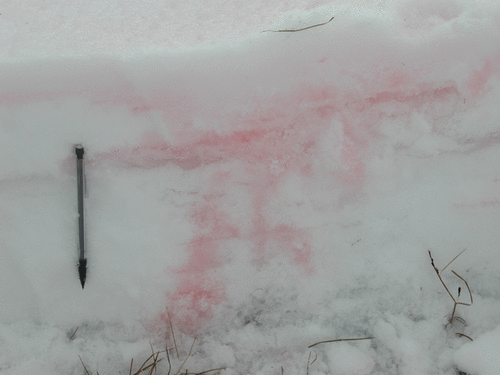当前位置:
X-MOL 学术
›
Environ. Sci. Technol.
›
论文详情
Our official English website, www.x-mol.net, welcomes your
feedback! (Note: you will need to create a separate account there.)
A Pulse of Mercury and Major Ions in Snowmelt Runoff from a Small Arctic Alaska Watershed
Environmental Science & Technology ( IF 10.8 ) Pub Date : 2017-09-20 00:00:00 , DOI: 10.1021/acs.est.7b03683 Thomas A. Douglas 1 , Matthew Sturm 2 , Joel D. Blum 3 , Christopher Polashenski 1, 4 , Svetlana Stuefer 5 , Christopher Hiemstra 1 , Alexandra Steffen 6 , Simon Filhol 1, 2 , Romain Prevost 7
Environmental Science & Technology ( IF 10.8 ) Pub Date : 2017-09-20 00:00:00 , DOI: 10.1021/acs.est.7b03683 Thomas A. Douglas 1 , Matthew Sturm 2 , Joel D. Blum 3 , Christopher Polashenski 1, 4 , Svetlana Stuefer 5 , Christopher Hiemstra 1 , Alexandra Steffen 6 , Simon Filhol 1, 2 , Romain Prevost 7
Affiliation

|
Atmospheric mercury (Hg) is deposited to Polar Regions during springtime atmospheric mercury depletion events (AMDEs) that require halogens and snow or ice surfaces. The fate of this Hg during and following snowmelt is largely unknown. We measured Hg, major ions, and stable water isotopes from the snowpack through the entire spring melt runoff period for two years. Our small (2.5 ha) watershed is near Barrow (now Utqiaġvik), Alaska. We measured discharge, made 10 000 snow depths, and collected over 100 samples of snow and meltwater for chemical analysis in 2008 and 2009 from the watershed snowpack and ephemeral stream channel. Results show an “ionic pulse” of mercury and major ions in runoff during both snowmelt seasons, but major ion and Hg runoff concentrations were roughly 50% higher in 2008 than in 2009. Though total discharge as a percent of total watershed snowpack water equivalent prior to the melt was similar in both years (36% in 2008 melt runoff and 34% in 2009), it is possible that record low precipitation in the summer of 2007 led to the higher major ion and Hg concentrations in 2008 melt runoff. Total dissolved Hg meltwater runoff of 14.3 (± 0.7) mg/ha in 2008 and 8.1 (± 0.4) mg/ha in 2009 is five to seven times higher than that reported from other arctic watersheds. We calculate 78% of snowpack Hg was exported with snowmelt runoff in 2008 and 41% in 2009. Our results suggest AMDE Hg complexed with Cl– or Br– may be less likely to be photochemically reduced and re-emitted to the atmosphere prior to snowmelt, and we estimate that roughly 25% of the Hg in snowmelt is attributable to AMDEs. Projected Arctic warming, with more open sea ice leads providing halogen sources that promote AMDEs, may provide enhanced Hg deposition, reduced Hg emission and, ultimately, an increase in snowpack and snowmelt runoff Hg concentrations.
中文翻译:

北极阿拉斯加小流域融雪径流中的汞和主要离子的脉冲
在春季需要卤素和雪或冰表面的大气汞消耗事件(AMDE)期间,大气汞(Hg)会沉积到极地地区。汞在融雪期间和融雪之后的命运很大程度上未知。我们在整个春季融化径流期间(共两年)测量了积雪中的汞,主要离子和稳定的水同位素。我们小的(2.5公顷)分水岭位于阿拉斯加的巴罗(现称乌特卡维克)附近。我们测量了流量,形成了1万个积雪深度,并在2008年和2009年从分水岭积雪和短暂河流中收集了100多个积雪和融化水样本进行化学分析。结果显示,在两个融雪季节,径流中汞和主要离子的“离子脉冲”,但是2008年的主要离子和Hg径流浓度比2009年高约50%。尽管这两个年份的总排放量占融化前流域积雪总当量的百分比在两个年份中相似(2008年融雪径流量为36%,2009年为34%),但有可能由于2007年夏季创纪录的低降水量导致了2008年熔融径流中较高的主要离子和汞浓度。2008年的溶解汞熔融水总径流为14.3(±0.7)mg / ha,2009年为8.1(±0.4)mg / ha,是其他北极流域报告的五到七倍。我们计算出2008年有78%的积雪汞汞以融雪径流的形式出口,2009年为41%。我们的结果表明AMDE汞与Cl形成复合物 2007年夏季的创纪录低降水量可能导致2008年熔体径流中较高的主要离子和汞浓度。2008年的溶解汞熔融水径流总量为14.3(±0.7)mg / ha,2009年为8.1(±0.4)mg / ha,是其他北极流域报告的五到七倍。我们计算出2008年有78%的积雪汞汞以融雪径流的形式出口,2009年为41%。我们的结果表明AMDE汞与Cl形成复合物 2007年夏季的创纪录低降水量可能导致2008年熔体径流中较高的主要离子和汞浓度。2008年的溶解汞熔融水径流总量为14.3(±0.7)mg / ha,2009年为8.1(±0.4)mg / ha,是其他北极流域报告的五到七倍。我们计算出2008年有78%的积雪汞汞以融雪径流的形式出口,2009年为41%。我们的结果表明AMDE汞与Cl形成复合物-或Br -可能是不太可能被光化学还原和再发射到前大气融雪,我们估计,大约25%的汞在融雪可归因于AMDEs。预计的北极变暖,以及更多的开放海冰引线提供了促进AMDE的卤素源,可能会增加汞的沉积,减少汞的排放,并最终增加积雪和融雪径流中的汞浓度。
更新日期:2017-09-20
中文翻译:

北极阿拉斯加小流域融雪径流中的汞和主要离子的脉冲
在春季需要卤素和雪或冰表面的大气汞消耗事件(AMDE)期间,大气汞(Hg)会沉积到极地地区。汞在融雪期间和融雪之后的命运很大程度上未知。我们在整个春季融化径流期间(共两年)测量了积雪中的汞,主要离子和稳定的水同位素。我们小的(2.5公顷)分水岭位于阿拉斯加的巴罗(现称乌特卡维克)附近。我们测量了流量,形成了1万个积雪深度,并在2008年和2009年从分水岭积雪和短暂河流中收集了100多个积雪和融化水样本进行化学分析。结果显示,在两个融雪季节,径流中汞和主要离子的“离子脉冲”,但是2008年的主要离子和Hg径流浓度比2009年高约50%。尽管这两个年份的总排放量占融化前流域积雪总当量的百分比在两个年份中相似(2008年融雪径流量为36%,2009年为34%),但有可能由于2007年夏季创纪录的低降水量导致了2008年熔融径流中较高的主要离子和汞浓度。2008年的溶解汞熔融水总径流为14.3(±0.7)mg / ha,2009年为8.1(±0.4)mg / ha,是其他北极流域报告的五到七倍。我们计算出2008年有78%的积雪汞汞以融雪径流的形式出口,2009年为41%。我们的结果表明AMDE汞与Cl形成复合物 2007年夏季的创纪录低降水量可能导致2008年熔体径流中较高的主要离子和汞浓度。2008年的溶解汞熔融水径流总量为14.3(±0.7)mg / ha,2009年为8.1(±0.4)mg / ha,是其他北极流域报告的五到七倍。我们计算出2008年有78%的积雪汞汞以融雪径流的形式出口,2009年为41%。我们的结果表明AMDE汞与Cl形成复合物 2007年夏季的创纪录低降水量可能导致2008年熔体径流中较高的主要离子和汞浓度。2008年的溶解汞熔融水径流总量为14.3(±0.7)mg / ha,2009年为8.1(±0.4)mg / ha,是其他北极流域报告的五到七倍。我们计算出2008年有78%的积雪汞汞以融雪径流的形式出口,2009年为41%。我们的结果表明AMDE汞与Cl形成复合物-或Br -可能是不太可能被光化学还原和再发射到前大气融雪,我们估计,大约25%的汞在融雪可归因于AMDEs。预计的北极变暖,以及更多的开放海冰引线提供了促进AMDE的卤素源,可能会增加汞的沉积,减少汞的排放,并最终增加积雪和融雪径流中的汞浓度。











































 京公网安备 11010802027423号
京公网安备 11010802027423号